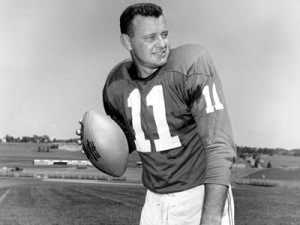
Brown stuck the lanning.
Adjusted Catch Yards are simply receiving yards with a 5-yard bonus for each reception and a 20-yard bonus for each receiving touchdown. In 2014,
Antonio Brown led the NFL with 2,603 Adjusted Catch Yards, the 5th highest total in NFL history. That was the result of a whopping 129 receptions for 1,698 receiving yards (both of which led the league) and 13 touchdowns.
Brown was dominant in 2014, and he led the NFL in more advanced systems, too. But today, I wanted to do something relatively simple. How do we compare Brown’s 2014 to say, three Packers greats from years past?
In 1992, Sterling Sharpe had 108 catches for 1,461 yards and 13 touchdowns. Those are pretty great numbers for 1992, although they don’t leap off the page the way Brown’s 2014 stat line does. If we go back farther, Billy Howton in 1956 had 55 receptions for 1,188 yards and 12 touchdowns. Like Brown, that was good enough to lead the NFL in two of the three major categories, and rank 2nd in the third. And 15 years earlier, Don Hutson caught 58 passes for 738 yards and 10 touchdowns. How do we compare that statline to Brown’s?
Here’s what I did.
1) Calculate each player’s Adjusted Catch Yards. For Brown, that’s 2,603. For Sharpe, Howton, and Hutson, it’s 2,261, 1,703, and 1,228, respectively.
2) Next, calculate the Adjusted Catch Yards for every other player in the NFL. Then, determine the baseline in each year, defined as the number of ACY by the Nth ranked player, where N equals the number of teams in the league. For Brown, that means using 1,398 Adjusted Catch Yards, the number produced by the 32nd-ranked player in ACY in 2014. For Sharpe, we use 1,078 ACY, the number gained by the 28th-ranked player in ’92. For Howton, it’s just 797, the number of ACY for the 12th-ranked player (keep in mind that ’56 was a very run-heavy year). And finally, for Huston, we use the 10th-ranked player from 1941, who gained only 413 Adjusted Catch Yards.
3) Next, we subtract the baseline from each player’s number of Adjusted Catch Yards. So Brown is credited with 1,205 ACY over the baseline, Sharpe gets 1,183 ACY over the baseline, Howton is 906 ACY over the baseline, and Hutson is 815 ACY over the baseline.
4) Finally, we must pro-rate for non-16 game seasons. For Brown and Sharpe, we don’t need to do anything, so Brown wins, 1,205 to 1,183. Howton played in a 12-game season, so we multiply his 906 by 16 and divide by 12, giving him 1,208 ACY, narrowly edging Brown. And in 1941, the NFL had an 11-game slate; multiply 815 by 16 and divide by 11, and Hutson is credited with 1,185 ACY.
As you can see, it wasn’t a coincidence I chose those three Packers seasons to compare to Brown. Those four seasons are the 19th-through-22nd best seasons of all time by this metric, and stand out as roughly equally dominant for their eras (both Sharpe and Hutson won the triple crown of receiving in their years).
This is not my preferred method of measuring wide receiver player, but it’s my favorite “simple” one. I put simple in quotes, of course, since there’s a lot of programming power behind generating these numbers. But at a high level, it’s simple: we combine the three main receiving stats into one, we adjust for era because the game has changed so much, and we pro-rate for years where the league didn’t play 16 games. Nothing more, nothing less. [continue reading…]





